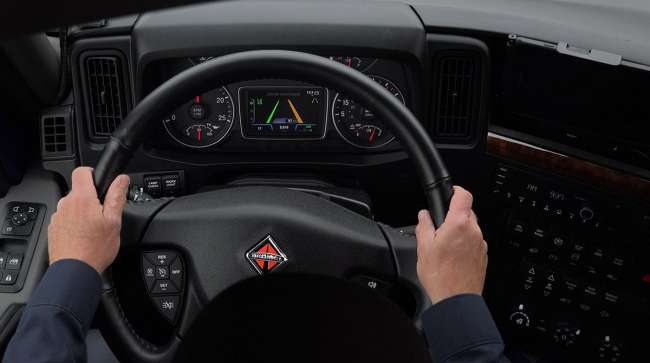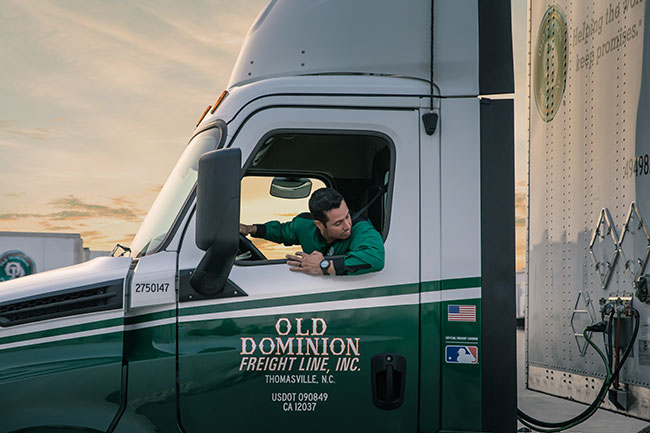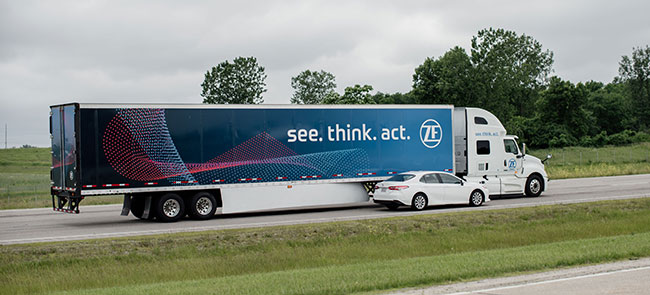Special to Transport Topics
Drivers, Fleets Become More Comfortable With Advanced Driver Assistance Systems

[Stay on top of transportation news: Get TTNews in your inbox.]
During the past decade, professional truck drivers have been introduced to more and more onboard safety systems designed to alert them to immediate risks and in many cases automatically intervene on their behalf to prevent crashes.
This proliferation of technology in the driver’s operating environment initially encountered resistance, but over time has become a more widely accepted and even embraced trend as drivers realize the benefits and discover how these systems can actually relieve stress, complement their skills and even reduce the physical demands of operating an 80,000-pound vehicle for hours at a time.
They’re called advanced driver assistance systems, or ADAS — technologies generally deployed to help drivers avoid crashes, whether the result of driver error or from circumstances outside of their control, such as inattentive or unsafe motorists.

Orr
ADAS includes everything from active braking and variable-power-assisted steering to video- and radar-enabled lane-keeping assist, blind-spot detection and warning, rollover prevention, active radar-enabled forward collision mitigation and video-generated side-of-truck displays that replace side mirrors. All are either actively deployed in thousands of trucks today or are in advanced pilot stages.
It’s almost as if today’s professional drivers need a scorecard to keep up, quipped Greg Orr, president of truckload carrier CFI and executive vice president for the North American truckload unit at its parent company, TFI International.
“Our drivers continue to adapt to new technology, which we support with training and education,” he said. “It’s a process. You always have a break-in period and familiarity time, but once [drivers] get used to the technology, understand and incorporate it into their skill set, they realize it helps make them better. The majority would tell you that.”
Even a decade into deployment of driver-assist technologies, as each new system is introduced there remains not so much resistance, but healthy skepticism “rooted in experience,” Orr said. “For the driver, any new system has to prove without a doubt two things: It does not diminish or get in the way of my ability to control and operate the truck, and it never fails or gives me false information.”
TFI ranks No. 11 on the Transport Topics Top 100 list of the largest for-hire carriers in North America.

Gibson
Angelo Gibson, vice president of operations at truckload carrier Werner Enterprises, believes that the driver-assist technologies that are becoming more prevalent in today’s passenger vehicles have eased driver acceptance of such technologies in trucks.
“Adoption is quicker today than in years past,” he said of advanced truck safety systems. However, “it still comes down to culture, are we educating and talking about it the right way. That matters when you are trying to get driver buy-in.”
His experience is that drivers today — whether veterans with many years behind the wheel or newly minted drivers — “are a lot more receptive.”
Nevertheless, some drivers are set in their ways, Gibson added.
Testing with groups of drivers and getting their feedback early on is key — for both fleets as well as manufacturers.
“Again, there is a process you have to go through to get people comfortable with change,” Gibson emphasized. “We do a really good job promoting [the advantages] and keeping things positive, educating on the benefits of the technology. That encourages buy-in.”

Maus
Drivers recognize the value, especially when safety technologies help prevent an incident or exonerate them from being at fault, said Jaime Maus, Werner’s vice president of safety and compliance.
“We know that at least 80% of crashes involving [commercial motor vehicles] are the other driver’s fault,” she said.
Before Werner rolled out forward-facing in-cab cameras fleetwide, she recalled both company drivers and owner-operators utilizing their own cab cameras because they “definitely understood the benefit from their perspective, which was to provide accurate footage should an incident occur.”
Werner ranks No. 16 on the for-hire TT Top 100.
Other fleets echo the importance of training and making sure drivers have a clear and accurate understanding of how an ADAS feature works and what it is intended to do.
“We make sure before we roll out any technology, whether retrofit or new, we have a good training program to bring drivers up to speed on what it does and how it affects operating a truck, what the signals mean,” said Sam Faucette, vice president of safety and compliance for less-than-truckload carrier Old Dominion Freight Line. “Then they learn what they can do in their driving to keep those [alerts] from happening.”

ODFL has deployed collision mitigation technology throughout its fleet and says the technology helped the company achieve its lowest accident frequency rate in 2020. (Old Dominion Freight Line)
Faucette noted that ODFL has had lane-departure warning and electronic stability control standard on ODFL equipment for many years, which has proven highly valuable in an operation that runs thousands of doubles.
However, collision mitigation technology has been the most important, he said.
“For a long time, it would only distinguish vehicles,” Faucette said of early front-facing collision warning systems. “We did not purchase them until they had improved and could recognize a stationary object as well.”

Faucette
Today active collision mitigation systems are a fleetwide feature on all trucks operated by ODFL, whose 11,328 drivers have an average 7-year tenure with the company. Faucette cited collision mitigation technology as the main factor in ODFL achieving its lowest accident frequency rate in 2020.
ODFL ranks No. 8 on the TT for-hire Top 100 list.
TFI’s Orr believes younger drivers just entering the field are less concerned about — and more amenable to — ADAS technology for two reasons. One, they’ve grown up with all manner of apps and technology on their smartphones. Two is not knowing, or being attracted to, the independence that drew many drivers into the business years ago.
“Most of today’s young drivers have never experienced the freedom of truly driving a truck like it was 20 years ago,” when drivers were much more on their own, Orr explained. “They don’t have that frame of reference. They’re comfortable with technology, so having tech in the cab isn’t a big deal. In fact, it’s expected and almost universally embraced.”
The Emergence of Active Steering
Both fleets and industry suppliers believe that as ADAS features continue to expand and engage with more aspects of operating a truck, visions of truly autonomous trucking will come into sharper focus.
And the next step in the ADAS journey is automated steering assistance.
“When we talk about migrating toward more driver assistance, you get into more understanding of the driver’s reactions and perspectives on the technology when in use,” said Julien Plenchette, vice president for ZF Friedrichshafen’s commercial vehicle business in the Americas.
The Germany-based global provider of vehicle motion control, safety and electric mobility technologies for commercial and passenger vehicles expanded its North American footprint and product line one year ago when it acquired component supplier Wabco Holdings Inc.
ZF currently has on the market ReAX, an active adaptive steering system that uses electronic steering technology to assist steering activity in commercial trucks, reading and adapting to signals from the truck as well as driver actions.
“It’s essentially [a system] that assists with turning the wheel,” Plenchette explained. “We can program certain logic into it that controls how much help or torque, or how little, is applied to the wheel to achieve the desired functionality.”
Key benefits, Plenchette said, include smoother, more precise steering and reduced driver fatigue.
The next step is marrying the current ReAX system with updates to ZF’s OnTraX lane-keeping functionality, adding advanced side-radar or camera sensors to support faster and more precise active blind spot detection and reaction, Plenchette said.
“That’s where the truck ... ‘sees’ a vehicle in an adjacent lane, and prevents you from moving into that lane, even if you have your turn signal on,” he said.

ZF Friedrichshafen demonstrates its OnTrax lane-keeping system, which is designed to support the driver and prevent the truck from merging into an occupied lane. (OnTraX3)
Ultimately the system can reduce driver fatigue by helping the driver avoid unsafe lane changes and maintain the lane, especially in challenging and stressful situations such as high winds or a difficult roadway where the truck would tend to drift left or right and need constant correction due to the pavement’s condition. ZF is currently testing this next-generation ADAS technology and plans to introduce it for commercial use soon with a major OEM.
As automated steering assistance capabilities become available on trucks, not all fleets are jumping on the bandwagon.
“I’ve personally gotten behind the wheel and tested it,” said TFI’s Orr, adding that conversations he has had with his professional drivers revealed concerns over potential loss of control.
“It’s one thing to have active steering assist in your personal car,” he said. “It’s another thing entirely when you’re operating an 80-foot-long, 80,000-pound vehicle down the road, amongst traffic. I can appreciate it being a little unnerving [for a professional driver].”
Yet with sufficient training, time and familiarity, he believes that this next ADAS functionality will eventually be embraced by drivers.
Bendix Commercial Vehicle Systems also offers a commercial active steering system, currently available on Navistar’s LT line of vehicles. Plans are to expand it to more OEMs.

Pettit
Paul Pettit, vice president of maintenance for truckload carrier Dart Transit, has worked with component suppliers on early design testing of automated steering assistance systems.
“Drivers didn’t really care for it,” he said of the early pilots. “They feel like they are not in control as much as they would like to be.”
“That’s not an uncommon reaction for new technology,” he said, adding that ultimately driver acceptance will come.
As the design and functionality mature, “we will look at [continued] testing in the future” prior to buying, Pettit said.
Dart Transit ranks No. 74 on the TT for-hire Top 100.
As active steering rolls out, it will complement Bendix’s current ADAS lineup, marketed as Wingman Fusion, which offers automatic emergency braking as well as a host of alerts to help the driver operate safely on the road.
Bendix’s active steering product offers lane-keeping assist, which provides safety benefits and convenience features designed to complement the driver’s skills, reduce driver fatigue and muscle strain, and enhance performance.
“What we really focus on is reliable, drivable systems that offer return on investment,” said T.J. Thomas, director of marketing and customer solutions at Bendix’s control group.
Any technology deployment must align with the fleet’s goals and expectations, he added.
One of the most important success factors, Thomas said, is training, training and more training. He cited Bendix’s extensive library of online training tools and its focus on advance training for both drivers and technicians so they understand how the systems operate and know what to expect.
Want more news? Listen to today's daily briefing below or go here for more info:




